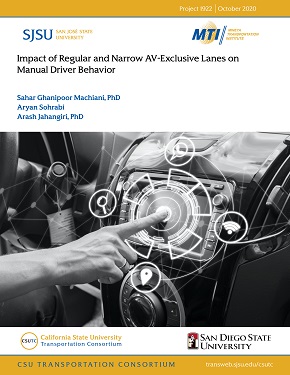- 408-924-7560
- mineta-institute@sjsu.edu
- Donate
Impact of Regular and Narrow AV-Exclusive Lanes on Manual Driver Behavior
This study attempts to answer the question of how a narrow (9-ft) lane dedicated to Automated Vehicles (AVs) would affect the behavior of drivers in the adjacent lane to the right. To this end, a custom driving simulator environment was designed mimicking the Interstate 15 smart corridor in San Diego. A group of participants was assigned to drive next to the simulated 9-ft narrow lane while a control group was assigned to drive next to a regular 12-ft AV lane. Driver behavior was analyzed by measuring the mean lane position, mean speed, and mental effort (self-reported/subjective measure). In addition to AV lane width, the experimental design took into consideration AV headway, gender, and right lane traffic to investigate possible interaction effects. The results showed no significant differences in the speed and mental effort of drivers while indicating significant differences in lane positioning. Although the overall effect of AV lane width was not significant, there were some significant interaction effects between lane width and other factors (i.e., driver gender and presence of traffic on the next regular lane to the right). Across all the significant interactions, there was no case in which those factors stayed constant while AV lane width changed between the groups, indicating that the significant difference stemmed from the other factors rather than the lane width. However, the trend observed was that drivers driving next to the 12-ft lane had better lane centering compared to the 9ft lane. The analysis also showed that while in general female drivers tended to drive further away from the 9-ft lane and performed worse in terms of lane centering, they performed better than male drivers when right-lane traffic was present. This study contributes to understanding the behavioral impacts of infrastructure adaptation to AVs on non-AV drivers.
SAHAR GHANIPOOR MACHIANI
Dr. Machiani, PhD (Civil Engineering, Virginia Tech, 2014), is an Assistant Professor in the San Diego State University (SDSU) Department of Civil, Construction, and Environmental Engineering, an Associate Director (SDSU Director) of Safe-D National University Transportation Center, and the Co-Director of SDSU Smart Transportation Analytics Research (STAR) Lab. She has expertise in traffic safety, driver behavior modeling, and infrastructure-based safety systems.
ARYAN SOHRABI
Aryan is a second-year master’s student studying Computational Science with an emphasis in Data Science at San Diego State University. He received his bachelor’s in Computer Science from McMaster University (Ontario, Canada) in May 2018. His areas of interest are high-performance computing, artificial intelligence, and big data.
ARASH JAHANGIRI
Dr. Jahangiri, PhD (Civil Engineering, Virginia Tech, 2015), is an Assistant Professor in the San Diego State University (SDSU) Department of Civil, Construction, and Environmental Engineering and the Co-Director of SDSU Smart Transportation Analytics Research (STAR) Lab. His research studies the behavior of current and future transportation systems and aims to improve safety, mobility, and sustainability by utilizing data-driven approaches, emerging technologies, and simulation.
-
Contact Us
San José State University One Washington Square, San Jose, CA 95192 Phone: 408-924-7560 Email: mineta-institute@sjsu.edu






